Discover the World of Art with Minicuration News
Featured Art Pieces That Speak to the Soul
At Minicuration.com, we believe that every piece of art tells a unique story, and our 'Minicuration News' section is dedicated to bringing those stories to life. Each article delves into the fascinating world of a different art piece that we have available for sale. From emerging talents to established artists, our curated selections are designed to inspire art lovers and collectors alike. Our team is passionate about art and strives to share insights that go beyond the surface, exploring the inspiration and technique behind each work.
Whether you’re looking to enhance your collection or find the perfect piece to adorn your home, 'Minicuration News' offers a glimpse into the artistry that captivates us. Join us on this journey of discovery as we showcase a rotating selection of artworks, each accompanied by rich narratives and exclusive details about the artist. Embrace the beauty of art and support our featured artists at Minicuration.com, where every article is an invitation to explore and appreciate the artistic expression that surrounds us.


Analysis of "Vicarious" by JFeelgood
JFeelgood’s Vicarious offers a visually striking exploration of identity and indirect experience. A minimalist figure, drawn in simple lines and wearing a wide-brimmed hat, stands at the forefront, seemingly detached from the dynamic abstract background. The ambiguity of the figure’s role—as an observer or participant—mirrors the painting’s title, inviting viewers to consider the concept of vicarious experience, or living through another’s perspective.
The background is a vibrant contrast of colors and motion, with bold, fluid blue brushstrokes evoking the sky or water. These hues create a sense of depth and movement, contrasting with the bright pink foreground, which suggests land or a beach. Small yellow and pink marks introduce a focal point, possibly hinting at natural beauty.
The title Vicarious suggests experiencing life secondhand, aligning with the Self-Work series’ themes of introspection and identity. The painting invites contemplation on how much of our experiences are shaped by others, and the balance between active participation and passive observation.
Through its simple yet evocative design, Vicarious encourages viewers to reflect on how they engage with the world and explore the fluid nature of self and experience.
Art Analysis of "PIUMA" by Lisa Stalvey: A Poignant Tale of Missed Connection
PIUMA, an oil painting by Lisa Stalvey, encapsulates a narrative that transcends its striking landscape. Inspired by the concept of two lovers destined to meet on a majestic mountain after the rain, only to miss each other while gazing at the moon, the artwork offers a poignant reflection on longing, destiny, and the moments that slip away. Stalvey uses the natural world as a symbolic setting for this bittersweet story, creating an emotional and visual depth that resonates deeply with viewers.
Composition and Structure:
The painting's structure subtly suggests the separation of the lovers. The diagonal flow of the landscape, from the rolling green hills at the bottom to the vivid, swirling sky above, hints at the two figures’ paths diverging. The landscape, with its rising hills, reflects a journey upward—perhaps symbolizing the lovers’ ascent to their meeting place, only to be separated by the forces around them. The placement of the moon in the lower part of the sky captures the moment both figures, instead of meeting, find themselves gazing at the same celestial body, unknowingly close yet distant.
Use of Color:
Color plays a crucial role in conveying the emotional undertone of PIUMA. The cool, serene blues and greens of the foreground suggest calmness and stability—perhaps symbolizing the peaceful, yet lonely, earth beneath the feet of the lovers. In contrast, the sky is alive with passionate oranges, reds, and purples, evoking both the drama of the natural elements and the intensity of emotions. The blending of these warm and cool tones embodies the conflicting feelings of hope and despair, love and loss.
Texture and Technique:
The textured strokes, particularly in the sky, bring an organic, almost turbulent quality to the painting. The clouds, with their sweeping, fiery strokes, could be interpreted as the remnants of the rain—representing the fleeting nature of time and the lovers’ missed opportunity. The moon, a central figure in this narrative, is rendered softly, almost delicately, contrasting with the textured energy of the clouds. The moon’s soft glow adds a layer of romantic melancholy, as it becomes the silent witness to the lovers’ unfulfilled meeting.
Symbolism and Interpretation:
The symbolism in PIUMA is powerful. The mountain represents a place of majesty, elevation, and challenge—perhaps a metaphor for the journey and effort required for the lovers to find each other. The rain, now dissipated, signifies past turmoil or emotional storms that have passed, leaving behind a sense of renewal. However, despite the clearing of the storm, the lovers remain separated, each captivated by the moon, which represents shared longing. The moon, often a symbol of guidance and unity, here becomes a reminder of what could have been—two paths that nearly converged but missed by a matter of timing.
Emotional Impact:
Stalvey’s PIUMA is emotionally charged, filled with a quiet tension that mirrors the lovers’ unspoken story. The viewer can sense the loneliness in the tranquil hills, juxtaposed with the emotional intensity of the sky, reflecting the lovers’ internal states. The moment captured in this painting evokes a sense of bittersweet longing—of missed opportunities and the beauty of a love that, while deeply felt, remains just out of reach. This emotional complexity makes the artwork resonate on both a personal and universal level, as it speaks to the shared human experience of love, loss, and timing.
Conclusion:
Lisa Stalvey’s PIUMA is more than a landscape—it is a poetic expression of love and fate. Through her skilled use of color, texture, and symbolism, Stalvey brings to life the story of two lovers, so close yet separated by the whims of time and circumstance. The painting invites viewers to reflect on their own experiences of missed connections, while also offering a breathtaking visual experience that captures the beauty and tragedy of fleeting moments.
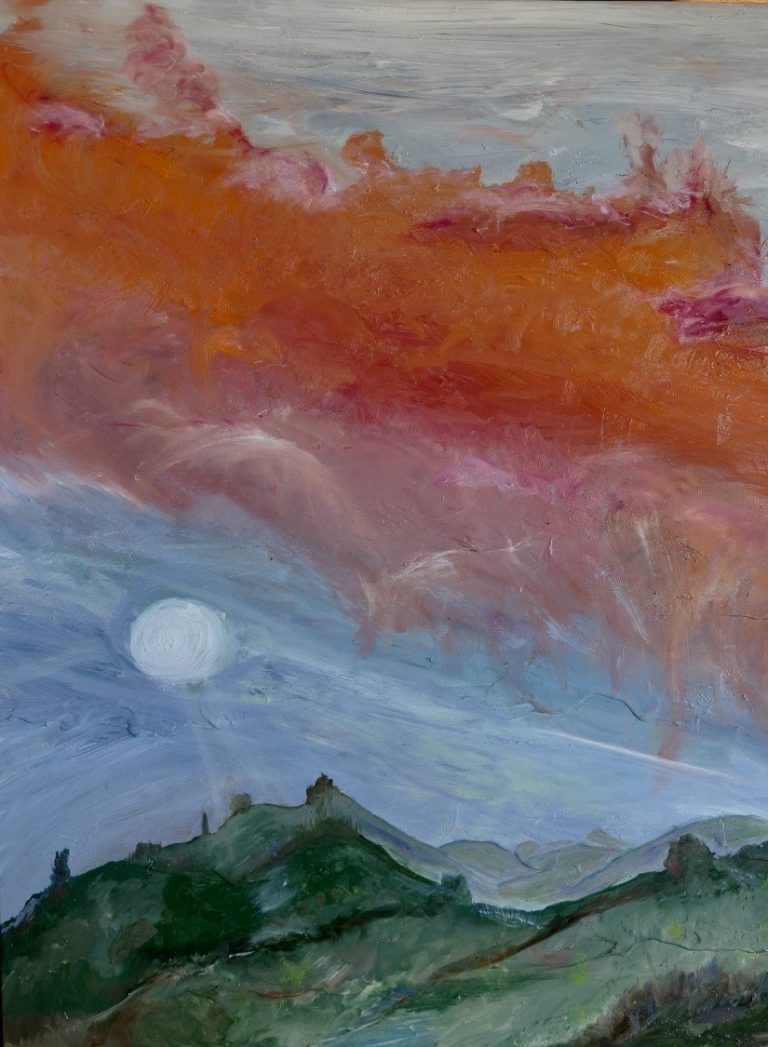

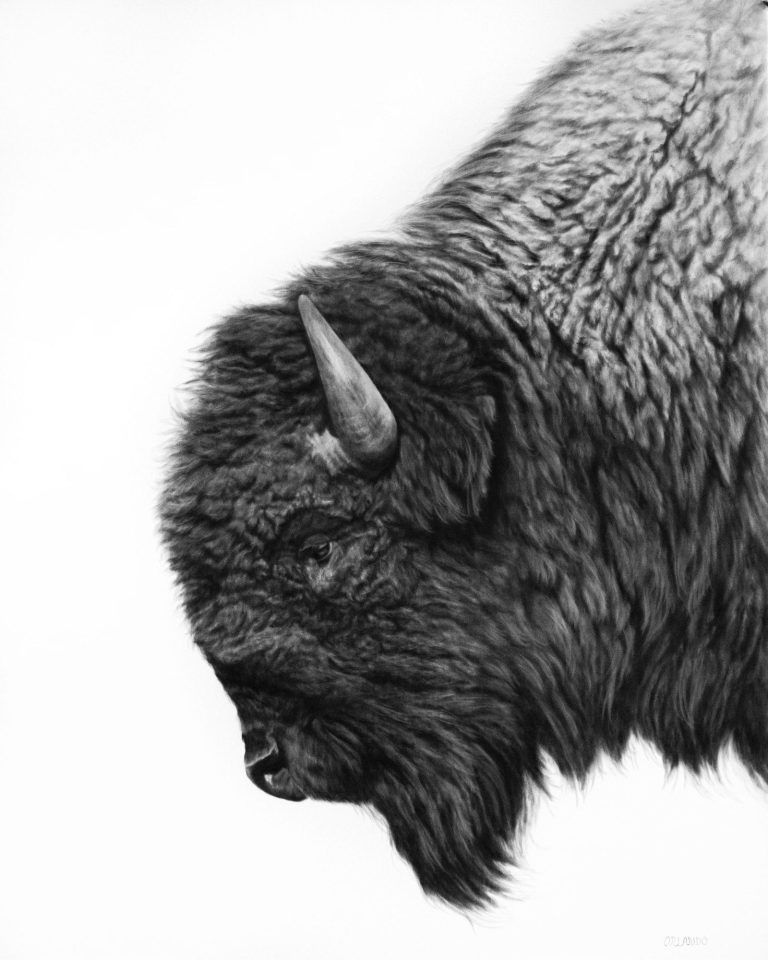

Art Analysis of "Part of the Gang" by Crystal Orlando – Charcoal Portrait of a Bison
"Part of the Gang," a remarkable charcoal piece by artist Crystal Orlando, captures the majesty and quiet strength of a bison with breathtaking realism. Orlando’s expertise in charcoal shines through in this monochromatic portrait, using intricate details to bring the texture of the bison’s thick fur and the solemn expression on its face to life.
Composition and Style:
Orlando’s decision to focus on a profile view of the bison highlights the powerful shape of the animal’s head, from the curved horn to its strong jawline. The minimalistic background ensures that all attention is directed toward the bison, allowing the viewer to fully appreciate its rugged beauty. The composition is balanced and serene, invoking a sense of respect for this mighty creature.
Technique and Texture:
One of the most striking aspects of "Part of the Gang" is Orlando’s mastery of texture. The artist skillfully manipulates the charcoal medium to depict the bison’s dense, coarse fur, emphasizing its natural strength and resilience. Each strand of fur is meticulously rendered, creating a lifelike representation that draws viewers into the tactile experience of the piece. The delicate shading around the eye adds emotional depth, hinting at the animal's wisdom and experience.
Symbolism and Emotion:
Bison, often regarded as symbols of endurance and power in the natural world, are celebrated in this portrait for their stoic beauty. The choice of charcoal, a medium known for its rawness and bold contrasts, further emphasizes the bison’s commanding presence. At the same time, there is an inherent vulnerability in the soft shading of the creature's expression, capturing a blend of strength and gentleness.
Conclusion:
Crystal Orlando’s "Part of the Gang" is a stunning example of the power of charcoal art. Through fine details and expert shading, Orlando brings the bison to life, celebrating both its physical presence and the symbolic weight it carries. This piece will undoubtedly captivate nature lovers and art enthusiasts alike, offering a timeless portrayal of one of nature’s most iconic animals.
Analysis of "Veritas" by JFeelgood
JFeelgood’s painting Veritas presents a semi-transparent woman seated on a theater stage, her hands resting gently on her chest. Framed by dramatic curtains, the stage setting suggests a performative aspect to her existence. The woman’s transparency may symbolize the fragility of identity or the sense of being unseen, as if her true self is elusive or unrecognized.
Her posture, with hands positioned protectively, hints at self-comfort, perhaps holding onto her essence in a chaotic world. The background features dripping, vivid colors that contrast sharply with the dark, static stage. These colors might represent the vibrant and complex nature of life, which contrasts with the roles people are often expected to perform.
The title, Veritas, Latin for truth, reflects the tension between the authentic self and the masks worn in public. The woman’s central placement on stage suggests that her struggle for genuine self-expression is not private but played out before an audience—whether literal or metaphorical.
Veritas explores the conflict between one's true self and the roles performed for others, inviting viewers to reflect on the layers of identity and the yearning for authenticity beneath societal expectations.

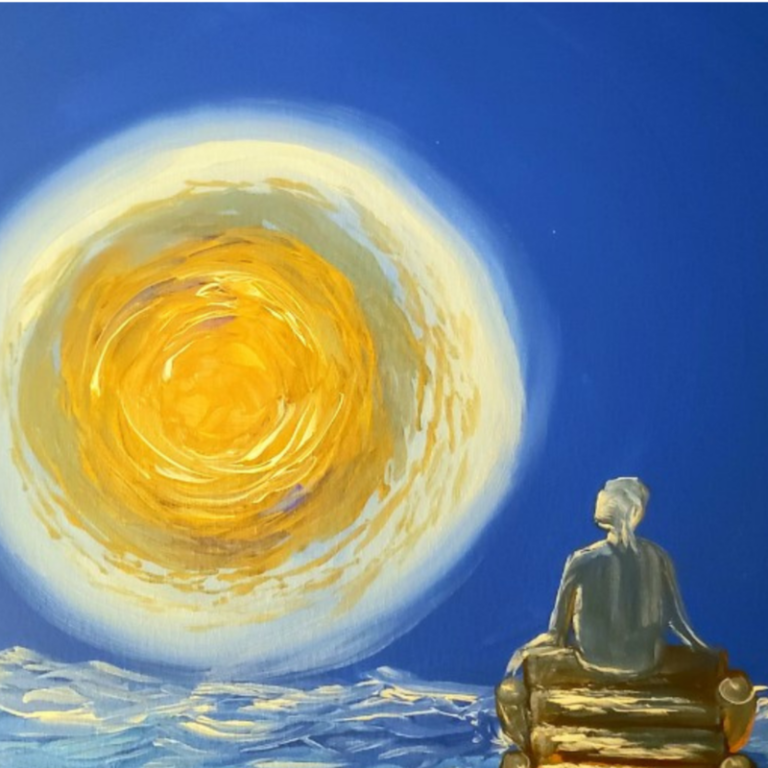
Analysis of "Transcend" by JFeelgood
JFeelgood’s Transcend blends the vastness of nature with a sense of personal reflection. The painting is dominated by a swirling golden orb, which may represent the sun or a symbol of enlightenment and self-actualization. The dynamic circular brushstrokes radiating from the orb suggest energy and power, evoking a force that is both nurturing and transformative.
Below the orb sits a silhouetted figure on a rocky outcrop, gazing towards the golden swirl. This positioning invites the viewer to project their own emotions onto the scene, as the figure remains anonymous and turned away.
The contrast between the serene blue background, possibly symbolizing sea or sky, and the vibrant gold emphasizes the duality of calmness and vitality. The golden light reflected on the water (or sky) underscores the connection between the figure and the universe, blending the physical and the metaphysical.
The title Transcend suggests surpassing ordinary existence, representing a spiritual awakening or personal insight. The painting invites viewers to contemplate their own journey toward growth, knowledge, and higher consciousness. Through this work, JFeelgood celebrates the individual's potential to rise beyond limitations while reflecting on the beauty and mystery of the universe.
Analysis of "Pooh" by JFeelgood
JFeelgood’s Pooh is a touching homage to Winnie the Pooh, capturing the character’s innocence and charm. The painting’s central figure is a golden, simplified version of Pooh, depicted in a reflective, dreamy pose. He holds onto a balloon, a symbol of childhood innocence and joy often associated with the beloved bear.
The background features an abstract blend of blues, purples, and whites, evoking a windy sky or clouds reminiscent of Pooh’s blustery adventures in the Hundred Acre Wood. The textured background contrasts with the smooth, solid form of Pooh and his balloon, adding dynamic depth to the painting.
The balloon, a recurring motif in Pooh’s stories, represents whimsy and simple pleasures. It lifts Pooh gently, suggesting a sense of lightness and imagination, themes central to both the character and the tales.
This painting’s nostalgic style and focus on a childhood literary icon reflect the lasting impact of early stories on the artist. JFeelgood's work invites viewers to reconnect with their own youthful innocence and the timeless comfort that Winnie the Pooh represents, celebrating the enduring magic of childhood stories that inspire creativity and joy across generations.

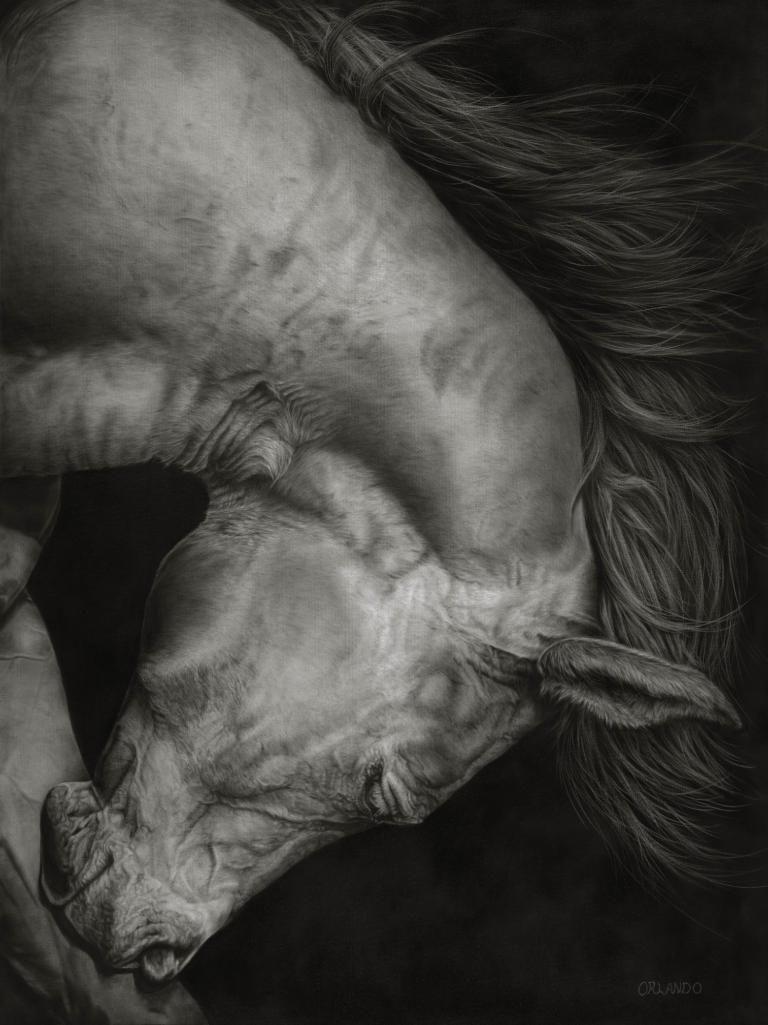

Art Analysis of "Take the Bow" by Crystal Orlando – Charcoal Horse Portrait
"Take the Bow," a stunning charcoal drawing by Crystal Orlando, exemplifies her masterful ability to capture both the grace and power of equine beauty. This striking piece portrays a horse mid-bow, its muscles rippling beneath its smooth coat, conveying not just the physical majesty of the animal but also an almost spiritual connection between horse and viewer.
Composition and Detail:
The horse’s head is tilted downward, caught in a moment of movement that is both elegant and powerful. Orlando’s choice to depict the horse from this unusual angle creates an intimate portrayal, drawing attention to the horse’s finely rendered anatomy. The delicate lines and careful shading highlight every muscle, wrinkle, and strand of the horse’s mane, bringing lifelike realism to the piece.
Use of Charcoal:
Orlando’s mastery of charcoal is evident in the meticulous detail of "Take the Bow." The medium is perfect for capturing the horse’s smooth, muscular form and the subtle nuances of light and shadow that play across its body. The contrast between the horse's bright coat and the dark, textured background adds depth and emphasizes the subject’s prominence. Each stroke of charcoal breathes life into the horse, making its fur appear tangible and its mane seem to sway in the unseen breeze.
Emotion and Symbolism:
"Take the Bow" is more than a technical study of anatomy; it is a celebration of grace and submission. The bowing horse can be seen as a symbol of humility and strength, embodying both the majestic spirit of the animal and the reverence humans have for nature. Orlando’s choice of a downward gaze imbues the horse with a sense of calmness and serenity, inviting the viewer to reflect on the delicate balance between beauty and power.
Conclusion:
Crystal Orlando’s "Take the Bow" is a masterpiece of charcoal art, showcasing her exceptional skill in capturing the elegance of horses. With its rich textures, lifelike details, and emotive subject matter, this artwork speaks to both art lovers and equestrian enthusiasts alike, immortalizing the horse's grace in a timeless portrait.
Art Analysis of "The Dinner Date" by Crystal Orlando – Charcoal Portrait of a Grizzly Bear
The artwork, a charcoal piece by Crystal Orlando, presents a powerful and lifelike depiction of a grizzly bear. Using the medium of charcoal, Orlando captures intricate textures and dynamic contrasts, giving the bear an almost tangible presence. The bear's fur is meticulously rendered, highlighting the natural beauty of its coarse texture, while the dark background enhances the contrast, drawing immediate attention to the animal’s face. The play of light and shadow, a hallmark of charcoal, emphasizes the bear’s muscular structure and fur, creating a sense of depth.
The open mouth, sharp teeth, and intense gaze of the bear evoke a feeling of strength and dominance, characteristic of this majestic creature. The detailing in the eyes adds a layer of realism, conveying emotion and intelligence. Orlando’s use of soft shading around the snout contrasts with the darker areas around the mouth and eyes, guiding the viewer's attention while maintaining a natural flow.
Orlando’s expertise with charcoal allows her to depict both the softness of the fur and the hardness of the teeth and snout, making the artwork a study in textural contrast. The monochromatic nature of charcoal strengthens the overall mood, focusing on form and structure rather than color.
This piece is an excellent example of wildlife art that resonates with viewers, not only through its technical mastery but also through its emotional depth. By isolating the bear against a simple background, Orlando ensures that the focus remains on the creature itself, symbolizing both its primal power and beauty. The careful balance of realism and artistic expression makes this artwork a striking addition to any collection of wildlife art.
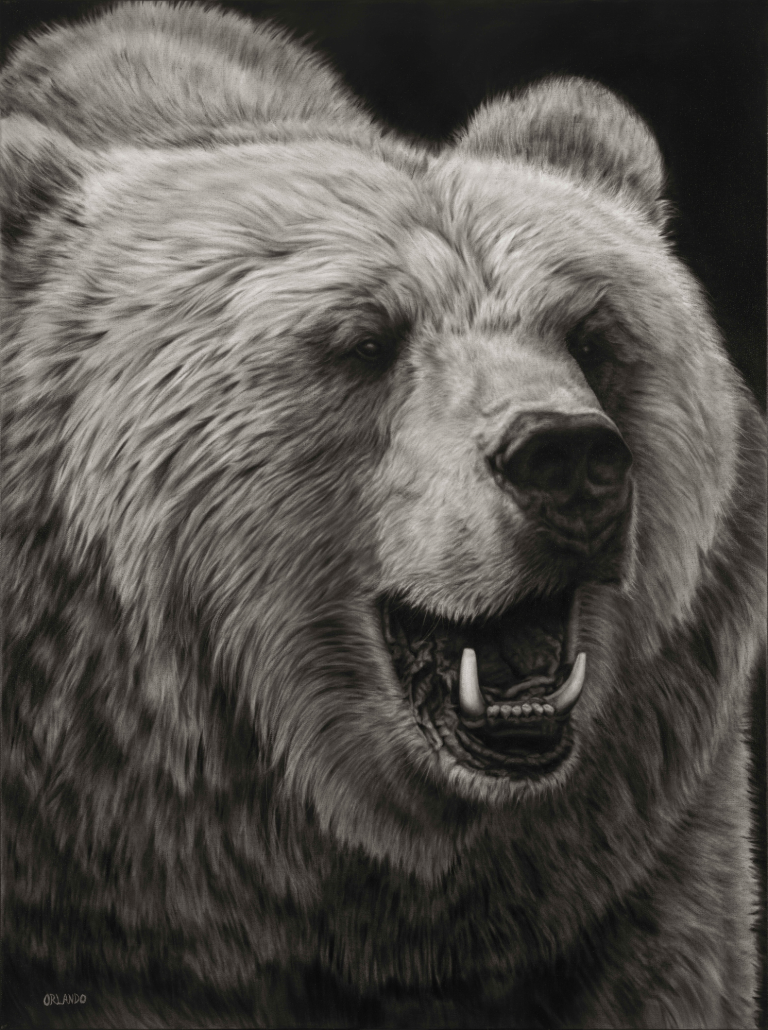


Analysis of "Grecia Monroc" by JFeelgood
JFeelgood’s Grecia Monroc portrays a stylized figure inspired by the artist’s friend, Grecia Monroc, an author and artist. The portrait emphasizes key features—oversized blue eyes and bold red lips—that draw attention to her neutral yet intense expression, evoking introspection.
Her black hair, painted with thick strokes, contrasts sharply with her pale skin and the light background adorned with golden flourishes. These decorative elements lend the painting an air of elegance and refinement, while also adding texture and depth to the figure.
Dressed in a dark garment with a woven or textured pattern, the subject’s attire is highlighted with more gold embellishments, creating visual harmony with the background and hair. A notable feature is a pendant necklace with a blue gemstone, which serves as a focal point and complements the vivid blue of her eyes.
The painting’s modern style, characterized by strong lines and bold colors, captures a personal and expressive interpretation of Grecia Monroc, suggesting qualities of creativity and strength. Classical references in the title and gold details evoke a sense of timelessness, aligning the subject with the enduring qualities of muses in art and literature.
Analysis: "Dreamfall" by JFeelgood
JFeelgood’s Dreamfall is a captivating painting that juxtaposes bold contrasts in color and texture to evoke a sense of both serenity and unease. The background features a deep purple, softened by mauve brushstrokes resembling wings or petals, adding an ethereal quality.
At the center, a white figure appears to be free-falling, with outstretched limbs that suggest a release or surrender. This figure contrasts sharply with the dark patch resembling hair or a void, adding a sense of mystery.
Gold leaf strips run vertically across the canvas, evoking rays of light or a symbolic fall from grace. The use of gold against the purple background gives the piece a regal, almost spiritual aura, further deepening its emotional impact.
The painting’s title, Dreamfall, invites interpretations around dreams, innocence, and the beauty within chaos. The figure’s relaxed posture amid the descent suggests a peaceful embrace of the unknown.
Overall, Dreamfall combines dynamic motion with stillness, allowing the viewer to reflect on personal experiences of falling, dreaming, and the balance between control and surrender.


Analysis of Dream Mountain: Painting by JFeelgood
JFeelgood’s painting is a captivating landscape titled Dream Mountain that evokes powerful emotions through its use of vivid colors and swirling brushstrokes. The piece showcases a dreamlike atmosphere, dominated by a vast, swirling sky that takes up the upper half of the canvas. The sky is painted with rich blues, purples, and a circular yellow-green orb, possibly representing a sun or moon, which creates a central focal point. This swirling orb adds a sense of motion and mysticism, drawing the viewer's eye to the heavens.
Below, the landscape presents a lush green terrain, transitioning into pointed mountain peaks in the distance. The green hills are textured with deep, impasto brushstrokes, giving them a three-dimensional quality and the impression of sunlight dancing over the surface. The yellow highlights suggest warmth, possibly the glow of the swirling celestial body above.
The contrast between the chaotic, swirling sky and the serene, stable mountains offers a balance between nature’s turbulence and tranquility. The use of bold, expressive brushstrokes throughout the painting emphasizes the intensity and dynamism of the scene. JFeelgood captures the ephemeral beauty of nature, inviting viewers to contemplate the relationship between the sky's eternal motion and the steadfastness of the earth below.
"Supernova" by JFeelgood: A Deep Dive into Color and Emotion
JFeelgood's "Supernova," a 24x36 acrylic painting, embodies an abstract yet emotionally resonant interpretation of nature and human contemplation. The use of vibrant, almost ethereal colors combined with minimalistic human form offers a window into the artist's creative vision, which blends the organic world with introspective themes.
The painting juxtaposes two distinct elements: a stylized, meditative figure in black and a dreamlike landscape filled with flowing, energetic colors. The trees, painted in elongated strokes of green, seem to float against a backdrop of golden yellow and misty blue. These colors evoke a sunrise or cosmic explosion, which could allude to the title "Supernova," symbolizing both destruction and creation.
The waterfall-like drips of yellow and blue create a sense of motion, suggesting the fluidity of time and emotion. The figure in black, isolated in the lower right corner, faces away from the viewer, seemingly lost in thought. This adds a layer of mystery and solitude, inviting interpretations around themes of introspection, isolation, or even renewal.
The contrast between the figure's stark, monochromatic design and the dynamic, colorful background draws attention to the relationship between the internal self and the external world. The landscape’s soft, flowing quality contrasts with the sharpness of the figure, suggesting a disconnect or a search for balance between human emotion and the environment.
JFeelgood’s acrylic techniques—layering, blending, and dripping paint—lend the work a sense of spontaneity and movement, much like the cosmic event a supernova represents. The brushstrokes are both deliberate and freeform, reflecting the chaos and beauty inherent in both nature and the human experience.
Overall, "Supernova" is a visually engaging piece that blends abstract elements with symbolic depth, making it a reflection on the broader themes of existence, transformation, and emotional exploration. Through a masterful balance of color and form, JFeelgood invites the viewer to engage with both the cosmic and the personal.
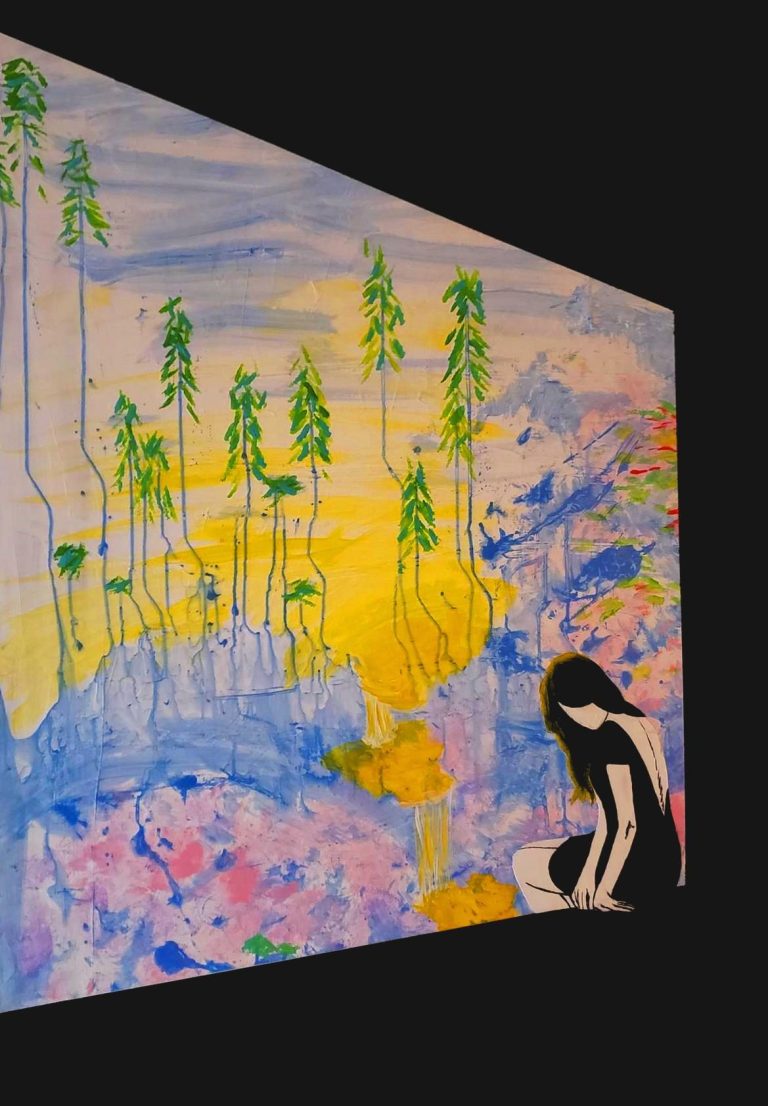


Crowned: An Analysis of JFeelgood's Painting
This painting presents a striking, stylized figure set against a deep red background. The figure wears a somber expression, with elongated facial features that suggest a sense of melancholy or contemplation. Dominated by a rich color palette of reds, blacks, and white, the painting also incorporates touches of green, particularly in the crown-like headpiece adorned with leaves. This natural motif may symbolize a connection to nature or a regal status.
The figure appears to be clad in armor, hinted at by the prominent shoulder piece bearing a green emblem. This contrast between the organic crown and the metallic-like armor evokes an interesting duality between vulnerability and strength, humanity and power.
The background's intense red color adds depth and emotional resonance to the painting, potentially representing themes of passion, royalty, or inner conflict. JFeelgood’s use of thick, bold brushstrokes adds texture and movement to the composition, contributing to its expressionist feel. The abstract elements emphasize emotional impact over precise realism, making the viewer focus on the mood rather than the specifics.
Overall, this piece masterfully blends abstraction and symbolism, inviting the audience to explore themes of identity, power, and emotional complexity through the dramatic contrast of color and form.
Analysis of JFeelgood's Painting: Businessman
Feelgood's Businessman, part of his celebrated Self-Work series, explores themes of ego, identity, and personal growth. The minimalist yet striking painting, featured on Minicuration.com, centers on a stylized human figure that exudes simplicity while conveying deep introspection. The figure is painted in bold, fluid lines, with its elongated form framed by a stark black arc, creating a sense of isolation or focus. This black shape contrasts dramatically with the neutral tones of the figure, symbolizing the internal struggle of ego— a recurring theme in JFeelgood's work.
The figure's posture, with one arm extended and a sense of movement in the legs, suggests forward motion, possibly indicating progress or evolution. Set against a grid-like background of red rectangles, the structured, repetitive pattern may symbolize the constraints of societal expectations or the rigidity of the business world. The contrast between the organic figure and the geometric backdrop reflects the tension between personal identity and external pressures.
As one of the most acclaimed pieces in the Self-Work series, Businessman captures the journey of ego— its flaws and strengths— in a world that often measures success through external achievements. The painting invites viewers to reflect on their own relationship with identity and ambition.

©Copyright. All rights reserved.
We need your consent to load the translations
We use a third-party service to translate the website content that may collect data about your activity. Please review the details in the privacy policy and accept the service to view the translations.
